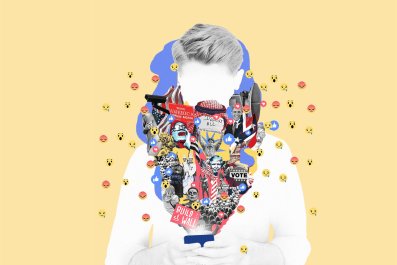Carol Steen's father once corrected her about the color of the number five. That number is yellow, she told him. "And my father said, 'No, it's yellow ocher.'" Her dentist has done a root canal because she said her tooth was "glowing orange."
Steen, her father and some of her cousins' children have a trait called synesthesia—and the source may be their shared DNA. A team of scientists announced Monday in Proceedings of the National Academy of Science that six genes, including some involved in brain cells' growth and connections, may be linked with synesthesia.
Amanda Tilot, a researcher at the Max Planck Institute for Psycholinguistics, and her colleagues put three families through a genetic sequencing protocol called whole exome sequencing. In two families, a woman, her mother and all her daughters had the trait: Specifically, they experienced sounds to be certain colors. In another family, a man's mother, daughter, sister and grandson all had synesthesia.
(Two important things to note: Not all people with synesthesia have overlapping senses, and Steen's family wasn't one of the ones studied.)
Prior studies have attempted to pinpoint the genetic underpinning for synesthesia. But whole exome sequencing is far more precise than the techniques used in other genetic analyses, Tilot told Newsweek. "That gave us the accuracy we needed to point to specific genes."
The researchers found six specific genes that looked a bit different among the people who had synesthesia in these families. Known as COL4A1, ITGA2, MYO10, ROBO3, SLC9A6 and SLIT2, all of those genes are related to a process called axonogenesis, something neurons require to connect to each other.
Other studies have also suggested the way brain cells connect might be different in people with synesthesia. "It does hold nicely with what people have been hypothesizing about, and what the neuroimaging literature suggests about how synesthesia might develop," Tilot said.

Only about 4 percent of people have synesthesia, according to one 2006 estimate. The ability may seem intriguing, but why should someone who might never experience the world as synesthetes do care about this research? Two words: The Dress.
Remember The Dress? The Internet went crazy over a garment that some people saw as white and gold and others saw as blue and black. That phenomenon is related to synesthesia: People perceive things differently.
"Sensory perception is something that has natural variation," explained Tilot. That variation, which includes synesthesia, is normal. It may even reflect the flexibility of our brains—an interesting question for everyone, even if the letter A isn't pink, or the number five isn't ocher.
Usually that flexibility goes undetected. "Until something like [the dress] comes up, we usually have no idea that there are differences in our how neighbors perceive different aspects of the world," said Tilot. "That's how synesthetes feel. They often have no idea that they experience the world differently from other people. It only becomes a term to them when they read about it or they mention it to someone else and get kind of a surprised response."
Learning to Live With It
"Surprised" is one possible reaction. Steen realized she saw the world differently as a 7-year-old living in Detroit. The reaction of the person she told was more than surprise. As she was walking home with her best friend from their elementary school, she described, "I just said it. I said, 'The letter A is the prettiest pink I've ever seen.'"
"She said, 'You're weird.' We continued our walk home, but now we were in silence. We never talked again."
Today, Steen freely discusses her synesthesia. An artist and a professor, she co-founded the American Synesthesia Association in 1995. Her synesthesia even feeds into her art. "When I go to the art store, I have already selected which piece of music I want to work with. I'll put on headphones and I'll go to the oil paint section and I'll very gently remove a cap, and if the color inside the tube matches the color that I'm seeing in my mind's eye, I buy the tube," she said.
But that correction she got from her father was one of the last times they ever discussed their shared trait. "He never talked about it again."















